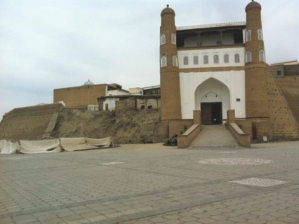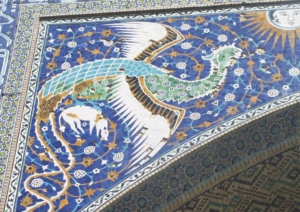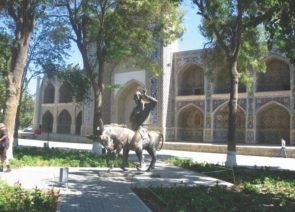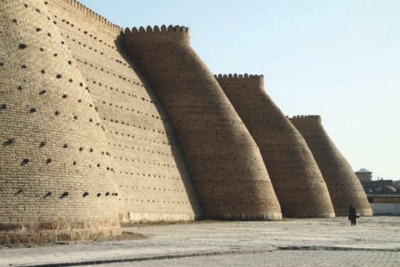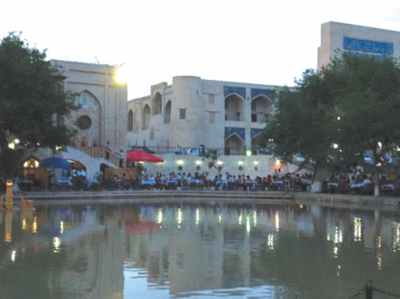| Home - Back Issues - The Team - Contact Us |
 |
| Volume 12 |Issue 05| February 01, 2013 | |
|
|
A Roman Column
A CENTRAL ASIAN JOURNEY BOXORO: Bokhara Neeman Sobhan
That is how this fabled city of the Silk Road, now in modern Uzbekistan, is pronounced in the local Persian dialect: BOKHORO and written with an 'x'. The influence of Persian is everywhere, as we will see during our two and a half day stay. We have driven from Samarkand, a long five hour ride, starting after lunch and a short visit to the tomb of Imam Bokhari in the outskirts of Samarkand. Images of the fields of roses in the garden outside the tomb dance in my head as we drive through dusty, desert like terrain. We arrive in Boxoro before sunset. In the lobby of the quaint but comfortable hotel near the centre, we meet our guide. He discusses next day's schedule and takes his leave after suggesting some eating places for us. We freshen up and set out to explore, picking our way through a web of cobbled back-alleys. The narrow paths are clean but dark; and frankly, this is not quite how I had imagined Bokhara.
Suddenly the lane ends, and through an arch we enter an open space and are transfixed. We seem to have arrived on a lit stage, an illustration from a city in A Thousand and one Nights. Before us spreads a piazza-like area, sloping slightly towards a square pool of shimmering water reflecting the lights from the restaurants and eating places around it, whose tables and couches are set right to the edge of the twinkling water. The pool is flanked on three sides by domed and blue-tiled edifices akin to the Temurid structures we saw in Samarkand. On our east side is the Kukeldash madrasah, and to our north and west, two structures that we learn later are part of the Nadir Dewan Beghi ensemble: a khanka or hostel for traveling Sufis, and a Madrassah, its portal decorated with majolica mosaic tiles in the shape of a phoenix. This building is lit up in unreal blue light which also bathes the small park like area near it that slopes down to the pool. Here stands the statue of a man astride a mule. It is none other than that popular character of children's stories in Central Asia and the Indian sub-continent: the quick-witted Nasruddin Hodja. At the southern end where we stand gaping, brilliantly lit up shops and kiosks to our right and left display a dazzling array of arts and crafts. Music and the hum of happy people all around pull us into what we later learn is the heart of Bokhara.
This whole pulsating area is called the Lab-e-Hauz. My knowledge of Urdu and bits of Persian encountered in studying classical Urdu poetry in college come back like remembered perfume. Of course: the Lip of the Tank or Pond. We find low cushioned seats right at the labial edge of the pool. While the food comes to our table, we gaze at the swans drifting like paper boats in the glistening dark jelly of the water over which the Weeping Willows sway like velvet tassels. It is a magical evening, and as we walk back after dinner we are already under the spell of Bokhara.
Next morning, we start out with Fazal to uncover the mysteries of this city, one of the most ancient in central Asia, located in the oasis that formed part of Sogdiana, conquered by Alexander of Macedon after he seized Samarkand. Fazl is warming up: “Bokhoro dates back more than 2500 years and was mentioned in Avesta—the sacred book of Zoroastrianism.” I ask what we are going to see first. He smiles, “Well, there are more than 140 monuments from the middle ages alone.” I gulp; husband groans. Meantime, we are passing a café called Shakhriston. I have noted the special use of 'x' to indicate the epiglottal 'kh' in Boxoro, not to mention the rounded Persian 'o' for the 'a' sounds and assume the guttural Arabic 'h' must be literally transcribed as 'kh'. So I ask Fazl if the café's name relates to the word 'city' as in 'Shehristan'. Fazl nods, pleased; I beam, established for now as teacher's pet. Husband, not a morning person, only gazes wistfully at the inviting nook of the Shakhriston Café', dreaming of a leisurely pipe and a cup of tea. And we have not even started our day. Fazl is marching on. “The ancient settlements surrounding Bukhara developed into towns. All these towns had more or less a similar structure: the ark (citadel), the shakhristan (the planned residential core), and a necropolis outside the city limits.” Husband demurs and sets the ground rules for the day: “Hey, no necropolis, and lots of coffee breaks.”
We agree and start walking towards the old citadel, called also the Ark citadel. Fazl is chattering away:“This was the nucleus of this medieval town, the oldest monument in Bukhara. It was the residence of the local rulers and built on an artificial hillock, as you can see. It dates back to the third century B.C. Legend associates the ancient fortress with the names of mythical characters like Siayvush and Afrasiyab from the ancient eastern epic poem-'Shakhname.' I can see husband's eyes glaze over, so I distract Fazl by asking him what's inside the Ark citadel. Fazl replies: “It housed the residence of the emir, the salomkhona/greeting hall, the kurinishkhona /audience chamber, the police department, the stables, store houses, the treasury, the armory, the prison, the mint, mosques, mausoleums, jewellers' workshops…” Before husband's yawn blossoms fully I suggest to Fazl that we by-pass the fortress for now and walk through the medieval city centre, which I know is a World Heritage site of UNESCO. We take pictures beside the impressive cylidrical minaret called, Minorai Kalon, or the Great Minaret, 47 metres high (170 feet) made of baked bricks. Fazl tells us that the name 'Minora' means lighthouse, and that was how travellers on camel's back in the surrounding desert viewed this landmark to guide them. Just as husband looks around to find a place to rest his feet, Fazl points to the base of the minaret and says it was called Poi -Kalyan - “The foot of the great.” I leave a happy spouse in the shade of a monument and walk around taking pictures and posing in front of the Masjidy-Kalyan ( the main mosque of the city, which has been there since the 12th century) and opposite it, the Mir-i-Arab Madrasah, which Fazl explains has functioned as a religious college for 400 years and was one of the two Muslim colleges allowed to operate in the former Soviet Union. Now we all walk through the domed bazaars built by the Sheibanid khans. Several of them still retain their original names derived from their function, Toki or Cupola of Zargaron (Jewelers), Telpakfurushon (Cap - Makers), Sarrofon ( Money - Changers) etc. Soon it is time for lunch. After this we stroll through a functioning Hammam/Bath in its after hours. The inner chambers are still steaming. We visit a traditional puppet maker; look at some miniature paintings and ceramics but are discouraged by the exorbitant prices. Fazl asks if we want to see the inside of the Nadir dewan Beghi ensemble, but knowing that on the last evening there is a dinner and cultural show in the courtyard inside, we prefer to see it then and are ready to call it a day. I express a desire to see the mausoleum of Hazrat Bahauddin Naqshbandi and other historical monuments and sites like the Summer Palace of the Samanid Kings. Fazl takes leave and we return to the hotel. Our first day has not ended yet. We plan to return to the Lab-e-Hauz for dinner again, and look forward to our second day of Bokhara on the morrow. NEXT- BOKHARA 2: Bahauddin Naqshbandi
|
||||||||||||||||||||
Copyright
(R) thedailystar.net 2013 |

